欧洲文明史期末论文
- 格式:doc
- 大小:23.00 KB
- 文档页数:4
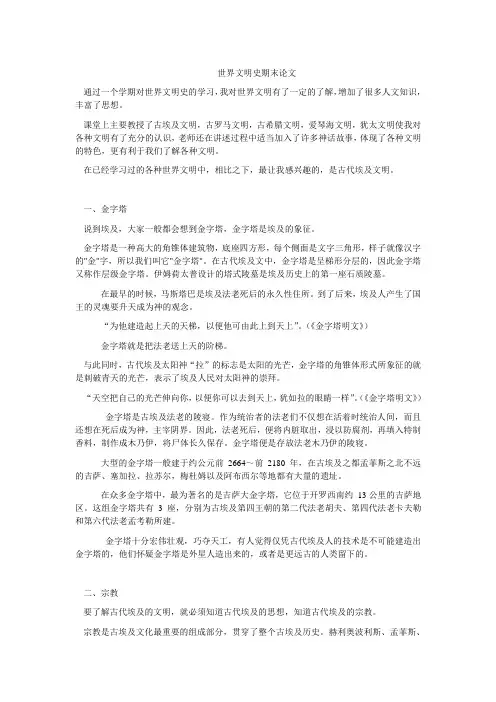
世界文明史期末论文通过一个学期对世界文明史的学习,我对世界文明有了一定的了解,增加了很多人文知识,丰富了思想。
课堂上主要教授了古埃及文明,古罗马文明,古希腊文明,爱琴海文明,犹太文明使我对各种文明有了充分的认识,老师还在讲述过程中适当加入了许多神话故事,体现了各种文明的特色,更有利于我们了解各种文明。
在已经学习过的各种世界文明中,相比之下,最让我感兴趣的,是古代埃及文明。
一、金字塔说到埃及,大家一般都会想到金字塔,金字塔是埃及的象征。
金字塔是一种高大的角锥体建筑物,底座四方形,每个侧面是文字三角形,样子就像汉字的"金"字,所以我们叫它"金字塔"。
在古代埃及文中,金字塔是呈梯形分层的,因此金字塔又称作层级金字塔。
伊姆荷太普设计的塔式陵墓是埃及历史上的第一座石质陵墓。
在最早的时候,马斯塔巴是埃及法老死后的永久性住所。
到了后来,埃及人产生了国王的灵魂要升天成为神的观念。
“为他建造起上天的天梯,以便他可由此上到天上”。
(《金字塔明文》)金字塔就是把法老送上天的阶梯。
与此同时,古代埃及太阳神“拉”的标志是太阳的光芒,金字塔的角锥体形式所象征的就是刺破青天的光芒,表示了埃及人民对太阳神的崇拜。
“天空把自己的光芒伸向你,以便你可以去到天上,犹如拉的眼睛一样”。
(《金字塔明文》)金字塔是古埃及法老的陵寝。
作为统治者的法老们不仅想在活着时统治人间,而且还想在死后成为神,主宰阴界。
因此,法老死后,便将内脏取出,浸以防腐剂,再填入特制香料,制作成木乃伊,将尸体长久保存。
金字塔便是存放法老木乃伊的陵寝。
大型的金字塔一般建于约公元前2664~前2180 年,在古埃及之都孟菲斯之北不远的吉萨、塞加拉、拉苏尔,梅杜姆以及阿布西尔等地都有大量的遗址。
在众多金字塔中,最为著名的是吉萨大金字塔,它位于开罗西南约13公里的吉萨地区。
这组金字塔共有3 座,分别为古埃及第四王朝的第二代法老胡夫、第四代法老卡夫勒和第六代法老孟考勒所建。
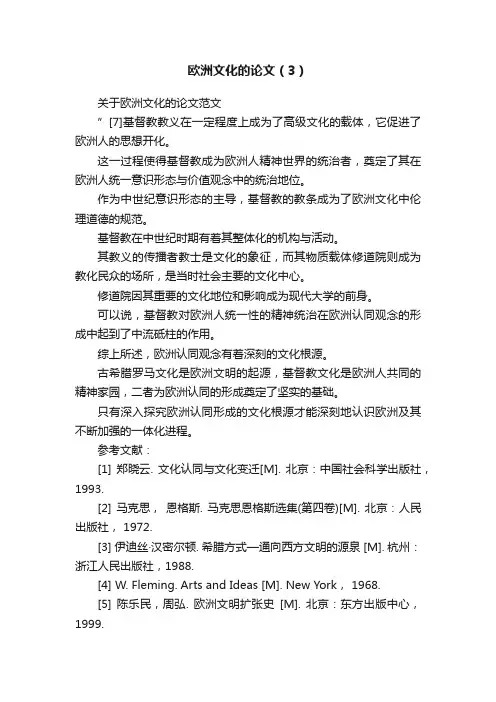
欧洲文化的论文(3)关于欧洲文化的论文范文”[7]基督教教义在一定程度上成为了高级文化的载体,它促进了欧洲人的思想开化。
这一过程使得基督教成为欧洲人精神世界的统治者,奠定了其在欧洲人统一意识形态与价值观念中的统治地位。
作为中世纪意识形态的主导,基督教的教条成为了欧洲文化中伦理道德的规范。
基督教在中世纪时期有着其整体化的机构与活动。
其教义的传播者教士是文化的象征,而其物质载体修道院则成为教化民众的场所,是当时社会主要的文化中心。
修道院因其重要的文化地位和影响成为现代大学的前身。
可以说,基督教对欧洲人统一性的精神统治在欧洲认同观念的形成中起到了中流砥柱的作用。
综上所述,欧洲认同观念有着深刻的文化根源。
古希腊罗马文化是欧洲文明的起源,基督教文化是欧洲人共同的精神家园,二者为欧洲认同的形成奠定了坚实的基础。
只有深入探究欧洲认同形成的文化根源才能深刻地认识欧洲及其不断加强的一体化进程。
参考文献:[1] 郑晓云. 文化认同与文化变迁[M]. 北京:中国社会科学出版社,1993.[2] 马克思,恩格斯. 马克思恩格斯选集(第四卷)[M]. 北京:人民出版社, 1972.[3] 伊迪丝·汉密尔顿. 希腊方式—通向西方文明的源泉 [M]. 杭州:浙江人民出版社,1988.[4] W. Fleming. Arts and Ideas [M]. New York, 1968.[5] 陈乐民,周弘. 欧洲文明扩张史[M]. 北京:东方出版中心,1999.[6] Anthony Pagden. The Idea of Europe [M]. Woodrow Wilson Center Press and Cambridge University Press. U.K. 2002.[7] 惠一鸣. 欧洲联盟发展史(上). 北京:中国社会科学出版社,2003年第1版.。
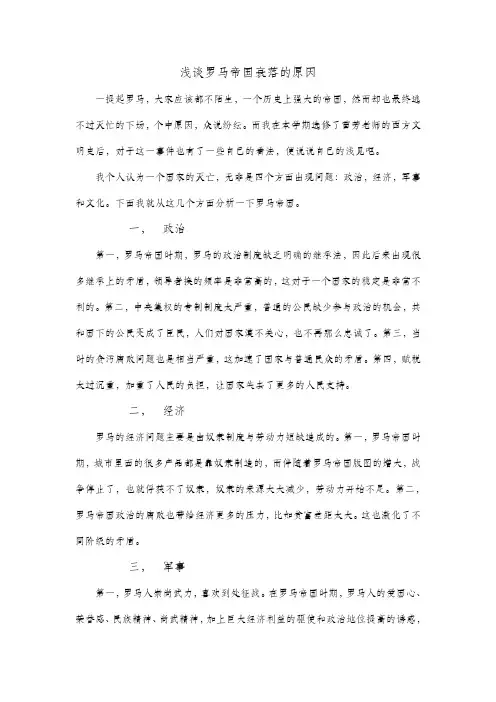
浅谈罗马帝国衰落的原因一提起罗马,大家应该都不陌生,一个历史上强大的帝国,然而却也最终逃不过灭忙的下场,个中原因,众说纷纭。
而我在本学期选修了雷芳老师的西方文明史后,对于这一事件也有了一些自己的看法,便说说自己的浅见吧。
我个人认为一个国家的灭亡,无非是四个方面出现问题:政治,经济,军事和文化。
下面我就从这几个方面分析一下罗马帝国。
一,政治第一,罗马帝国时期,罗马的政治制度缺乏明确的继承法,因此后来出现很多继承上的矛盾,领导者换的频率是非常高的,这对于一个国家的稳定是非常不利的。
第二,中央集权的专制制度太严重,普通的公民缺少参与政治的机会,共和国下的公民变成了臣民,人们对国家漠不关心,也不再那么忠诚了。
第三,当时的贪污腐败问题也是相当严重,这加速了国家与普通民众的矛盾。
第四,赋税太过沉重,加重了人民的负担,让国家失去了更多的人民支持。
二,经济罗马的经济问题主要是由奴隶制度与劳动力短缺造成的。
第一,罗马帝国时期,城市里面的很多产品都是靠奴隶制造的,而伴随着罗马帝国版图的增大,战争停止了,也就俘获不了奴隶,奴隶的来源大大减少,劳动力开始不足。
第二,罗马帝国政治的腐败也带给经济更多的压力,比如贫富差距太大。
这也激化了不同阶级的矛盾。
三,军事第一,罗马人崇尚武力,喜欢到处征战。
在罗马帝国时期,罗马人的爱国心、荣誉感、民族精神、尚武精神,加上巨大经济利益的驱使和政治地位提高的诱惑,造就了罗马军队强大的战斗力。
但是,繁荣盛世也成为了腐败的温床,当罗马帝国没有敌人可以征服的时候,他们开始沉浸于安逸的生活,花天酒地的生活磨灭了罗马人的进取心,腐蚀了罗马军人的斗志。
第二,罗马强大的军事力量被用于个人目的。
尤其是在罗马帝国后期,腐败导致帝王对军队的倚重和骄宠,对军队的过分骄宠更加加剧了官兵的腐败,从而形成了一种恶性循环,这大大销蚀了罗马军队的战斗力。
帝国后期,许多帝王荒淫豪奢、腐化至极,贵族地主挥金如土,醉生梦死,致使民不聊生、政局动荡。
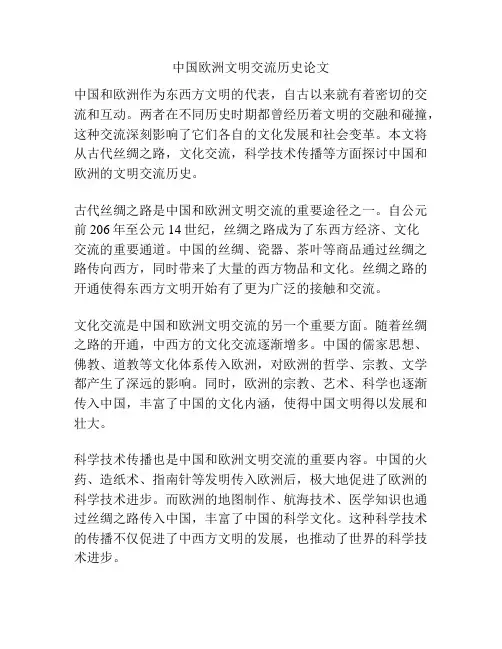
中国欧洲文明交流历史论文中国和欧洲作为东西方文明的代表,自古以来就有着密切的交流和互动。
两者在不同历史时期都曾经历着文明的交融和碰撞,这种交流深刻影响了它们各自的文化发展和社会变革。
本文将从古代丝绸之路,文化交流,科学技术传播等方面探讨中国和欧洲的文明交流历史。
古代丝绸之路是中国和欧洲文明交流的重要途径之一。
自公元前206年至公元14世纪,丝绸之路成为了东西方经济、文化交流的重要通道。
中国的丝绸、瓷器、茶叶等商品通过丝绸之路传向西方,同时带来了大量的西方物品和文化。
丝绸之路的开通使得东西方文明开始有了更为广泛的接触和交流。
文化交流是中国和欧洲文明交流的另一个重要方面。
随着丝绸之路的开通,中西方的文化交流逐渐增多。
中国的儒家思想、佛教、道教等文化体系传入欧洲,对欧洲的哲学、宗教、文学都产生了深远的影响。
同时,欧洲的宗教、艺术、科学也逐渐传入中国,丰富了中国的文化内涵,使得中国文明得以发展和壮大。
科学技术传播也是中国和欧洲文明交流的重要内容。
中国的火药、造纸术、指南针等发明传入欧洲后,极大地促进了欧洲的科学技术进步。
而欧洲的地图制作、航海技术、医学知识也通过丝绸之路传入中国,丰富了中国的科学文化。
这种科学技术的传播不仅促进了中西方文明的发展,也推动了世界的科学技术进步。
在中国和欧洲文明交流的历史长河中,东西方文明通常呈现出异质性、同质性复杂的状态。
这种文明交流和碰撞在丰富了各自的文化内涵的同时,也带来了相应的文化冲突和矛盾。
但正是这种交流与碰撞,使得中西方文明得到了相互的借鉴和提升,从而实现了文明交流的共赢。
总的来说,中国和欧洲的文明交流历史是一个丰富而复杂的过程,在这过程中中西方的文明不仅相互影响,而且相互促动,这种交流与碰撞不断推动着人类文明的进步和发展。
希望今后中西方之间的文明交流能够更加深入,使得世界各国的文明能够互相借鉴、共同发展。
此外,中国和欧洲的文明交流还在思想观念、政治制度、艺术风格等方面产生了深远影响。
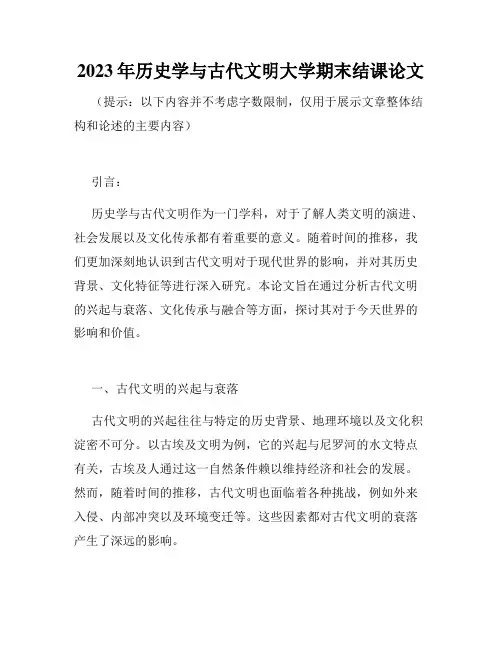
2023年历史学与古代文明大学期末结课论文(提示:以下内容并不考虑字数限制,仅用于展示文章整体结构和论述的主要内容)引言:历史学与古代文明作为一门学科,对于了解人类文明的演进、社会发展以及文化传承都有着重要的意义。
随着时间的推移,我们更加深刻地认识到古代文明对于现代世界的影响,并对其历史背景、文化特征等进行深入研究。
本论文旨在通过分析古代文明的兴起与衰落、文化传承与融合等方面,探讨其对于今天世界的影响和价值。
一、古代文明的兴起与衰落古代文明的兴起往往与特定的历史背景、地理环境以及文化积淀密不可分。
以古埃及文明为例,它的兴起与尼罗河的水文特点有关,古埃及人通过这一自然条件赖以维持经济和社会的发展。
然而,随着时间的推移,古代文明也面临着各种挑战,例如外来入侵、内部冲突以及环境变迁等。
这些因素都对古代文明的衰落产生了深远的影响。
二、文化传承与融合古代文明的影响不仅仅在于历史上的辉煌,更在于其对于后世文化的传承与融合。
例如,古希腊文明对于现代政治、哲学和艺术等领域产生了深远的影响。
希腊政治制度的民主理念、哲学家们的智慧思考以及建筑艺术的创造性都深深地影响着今天的世界。
类似地,古代中国文明的传承与创新,为今天中国的社会制度、文化习俗以及科学技术发展提供了坚实的基础。
三、古代文明对于今天世界的影响和价值古代文明对于今天的世界影响深远且不可忽视。
它们为我们提供了宝贵的历史经验和智慧,让我们能够更好地理解人类社会的演进和文化的多样性。
通过研究古代文明,我们可以更好地反思现代社会中的问题与困境,并寻找解决之道。
同时,古代文明也为今天的世界提供了丰富多样的文化遗产和旅游资源,对于促进文化交流与旅游发展具有积极的意义。
结论:在2023年这个特殊的时刻,我们对于历史学与古代文明的研究显得尤为重要。
通过深入剖析古代文明的兴衰、文化传承与融合等方面,我们可以更好地认识到古代文明对于今天世界的影响和价值。
同时,这也是我们深入了解和珍视人类文化多样性的契机。
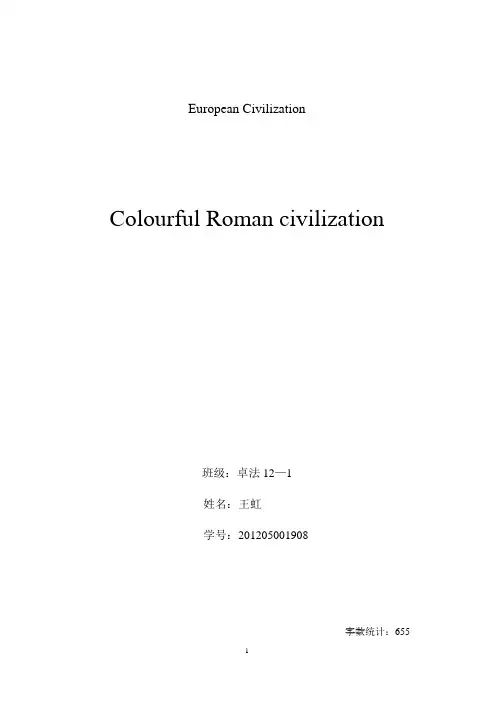
European Civilization Colourful Roman civilization班级:卓法12—1姓名:***学号:************字数统计:655“W o rl d h as a l ot o f b e au t i fu l wo r ds, on l y o n e w or d,p e opl e d o no t f i ght f o r i t, a nd i t l o c at es i n t h at po si t i o n q ui et l y w h i ch i s n ot s o b r i ght, l e av i n g i t t o t h at onl y c i t y. T he wo r d c al l e d gr e a t, t h e ci t y i s c al l e d “R o m e”.T hi s s e nt en c e d es cr i be s R om e wh i c h i s w ri t t en b y a f a m o us C hi nes e w ri t e r. Ex a c t l y,R om e i s a gl o r i o us c i t y a n d i t l e av e s m a n y v a l u abl e t h i n gs t h at w or t h l ea r ni n g. T h e m os t r e p r es e nt at i v e i s R o m an ci v i l i z at i o n.R om an ci v i l i z at i o n o ri gi n at e d i n It a l y,5t h c en t u r y B C G r e ek c l as si c al c ul t u r e w as hi gh l y p r os p e ro us w he n t he R om a n c i vi l i z a t i o n w as a ci t y-s t a t e j us t e nt e red. W i t h R om an’s ex p a ns i o n, t h e i n fl u e n c e o f t h e R o m an c ul t u r e w as i nc r e as i n g.C l a s s i c a l R om an c ul t u r e i s an i m po rt a nt p ar t o f w e s t e r n cul t u r e. W h e t h e r i n a r c hi t ec t u r e,r e l i gi o n, s ci e n ce, phi l os op h y,o r i n l i t e r at u re, a rt a n d ot h er as p ec t s o f Gr e e k cu l t ur e ca n b e s e en t h e i m p a c t an d i m p ri nt,i t i s c ont i n u at i on a n d d e ve l o p m ent o f G re e k cu l t u re, but i t's a c hi ev em e nt s i n t h es e a r ea s ar e m o re t h an G r ee c e e d ge.It i s s a i d t ha t“R om e W as n’t B ui l t i n a D a y”,w h i ch m e ans s u c c es s r e q ui r es a l on g-t e rm a cc um ul at i o n and e f fo rt s.E a r l y R o m ans w as a n a gri c ul t u r al n at i o n, i n a v e r y l o n g t i m e, t h e y h a v e m a i nt ai n ed an un s o phi s t i c a t e d,di l i ge nt a nd p r a gm at i c fol k. R e pu bl i c an e a rl y R om an’s l i fe w as s a vi n g an d not ex t r a v a ga nt; p e op l e w er e si m pl y d r e s s ed, e at i n g s i m pl e.In R om e, u n de r t h e i n fl u e n c e o f t h e na t i on a l s pi ri t, m ode s t y h a s b e com e t h e m o st i m p or t ant f e at u r e o f R om a n cu l t ur e.As t h e R om a n i n fl u en c e i s v e r y p r om i n en t on po l i t y,t h e d e ve l op m ent an d i m p r ove m e nt o f c u l t u r al i s al s o ob vi ou s, R om a n s oc i et y h a s gon e t h ro u gh t h e m on a r ch y e r a, t h e R e pu bl i c an e r a a nd t h e e r a o f Em pi re s t h r e e s t a ges.Th e r ef o r e, t h e po l i t i c a l p r a ct i ce o f t h e R om an s,ha s a dd e d m a n y n e w el e m e nt s t o t h e W es t er n p ol i t i c al t r adi t i on. B e s i d es, R om an h as h i gh er a c hi e v em en t o n t h e c on c ep t o f st a t e,r ul ed s u r ge r y,l e ga l, en gi n e er i n g a nd ot h er as p e ct s o f m i l i t a r y t e c hn ol o g y;a d v o ca t e d p er s ev e r an c e, o b edi e n c e,r e s p on s i bi l i t y, m o ra l i t y a m o n g c i t i z e ns.R om a n cul t ur e h as pl a ye d a v i t a l ro l e i n d e v el opm e nt.In t h e na t u r al s ci en c e s, t h e R om an na t i on h as a s t ro n g p r a ct i ca l s pi ri t of s c i e nt i f i c r at i o n al i t y,w hi c h s ho ul d c ons i s t s o f t wo a s p e ct s:fi rs t,m aki n g a n ci en t Gr e e k kn o wl ed ge b e i nt e gra t e d, a s w e l l as a m a s t e r o f t h e k no wl e d ge s ys t e m; S e c on d, f oc us i n g o n t h e s c i e nt i f i c k no wl e d ge t o pr od u ct i on a nd pr a c t i c es, t he r e b y c r e a t i n gt h e wo rl d's m ost h i ghl y d e v el o p ed p r od u ct i v e fo r c es.R om a ns e m ph as i s e d o n pr a c t i c al i t y,c l os el y r e l a t ed wi t h p e op l e's a gr o n om y,a r ch i t ec t ur e, m i l i t a r y,m e d i ca l, s u r v e yi n g a n d ot h e r p r a ct i ca l s ci e n ce an d t e c hn ol o g y h a s b e e n d e v el o p ed i n R om e, a nd m a d e gr e at a ch i e ve m e nt s. R om e’s pr a c t i c al an d t e c hno l o gi c al d e v el opm e nt i n agr i c ul t u r e w a s t he m os t p rom i n en t a n ci e nt w e st e r n pe r f or m an ce.Well, as far as I am concerned, I am interested in the part of law. In “the History of Rome” this book, it refers to law, and I get to know that Civil Law comes from jus civile of Roman law. Jus civile is in terms relative to the jus gentium, it is mainly to adjust the relationship between Roman citizens and foreigners, but when the Justinian compiled "Corpus Juris Civilis", the two laws have combined. Throughout the Civil Laws, Civil Law this word has multiple meanings, and it need to be distinguished. Civil Code and general provisions of the Civil Law, Civil Code has two forms, one is Romanesque. Jurist Roman Gaius came up with Romanesque in his book "Institutiones", Emperor Justinian adopted this form, and divided it into civil law, property law and procedural law. Famous German jurist Jhering said: "Rome had conquered the world three times, the first time is the use of force, the second is religion, and the third is law."Roman civilization is so abundant and profound that all human beings benefit from it; it is really enormous precious wealth.Reference:1.YuQiu yu, 《行者无疆》,华艺出版社,20012.Mommse n·T, the History of Rome, 商务印书馆,20053.Gaius, Institutiones, 中国政法大学出版社,2008。
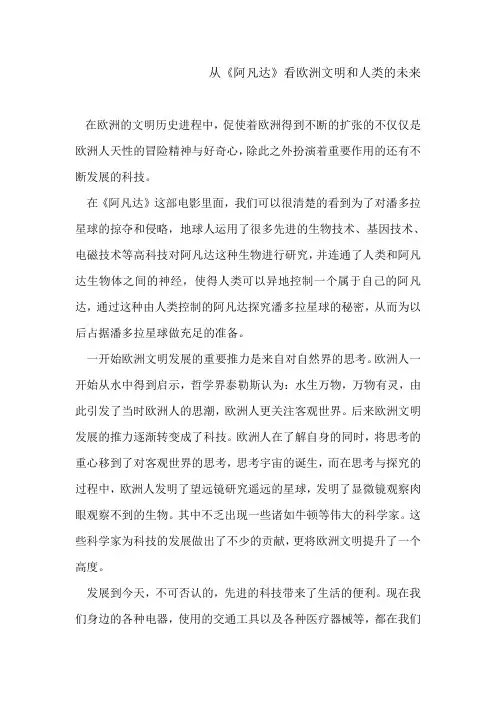
从《阿凡达》看欧洲文明和人类的未来在欧洲的文明历史进程中,促使着欧洲得到不断的扩张的不仅仅是欧洲人天性的冒险精神与好奇心,除此之外扮演着重要作用的还有不断发展的科技。
在《阿凡达》这部电影里面,我们可以很清楚的看到为了对潘多拉星球的掠夺和侵略,地球人运用了很多先进的生物技术、基因技术、电磁技术等高科技对阿凡达这种生物进行研究,并连通了人类和阿凡达生物体之间的神经,使得人类可以异地控制一个属于自己的阿凡达,通过这种由人类控制的阿凡达探究潘多拉星球的秘密,从而为以后占据潘多拉星球做充足的准备。
一开始欧洲文明发展的重要推力是来自对自然界的思考。
欧洲人一开始从水中得到启示,哲学界泰勒斯认为:水生万物,万物有灵,由此引发了当时欧洲人的思潮,欧洲人更关注客观世界。
后来欧洲文明发展的推力逐渐转变成了科技。
欧洲人在了解自身的同时,将思考的重心移到了对客观世界的思考,思考宇宙的诞生,而在思考与探究的过程中,欧洲人发明了望远镜研究遥远的星球,发明了显微镜观察肉眼观察不到的生物。
其中不乏出现一些诸如牛顿等伟大的科学家。
这些科学家为科技的发展做出了不少的贡献,更将欧洲文明提升了一个高度。
发展到今天,不可否认的,先进的科技带来了生活的便利。
现在我们身边的各种电器,使用的交通工具以及各种医疗器械等,都在我们的日常生活中扮演着不可缺少的角色。
但不能忽视的是科技也带来各种弊端。
生物技术的不断发展,出现了克隆技术,更给人类的伦理问题带来了重大的危机。
尽管克隆技术可以帮助人们克隆出一样的器官以拯救患病的人。
但是对于克隆出一个完整的生物,人们却不甚赞同。
因为克隆出一个完整的生物涉及的不仅仅是生物科技的问题,它涉及到的是更深层次的人伦问题。
近世纪以来,人们对此议论纷纷,始终没有得出一致的意见。
《阿凡达》这部电影里涉及到的生物技术更是克隆技术的升级版,直接将人的神经与阿凡达生物体的神经同步。
由此可以想象,人类的未来越来越依赖科技谋求发展,而且不断寻求身体器官的延展方法。
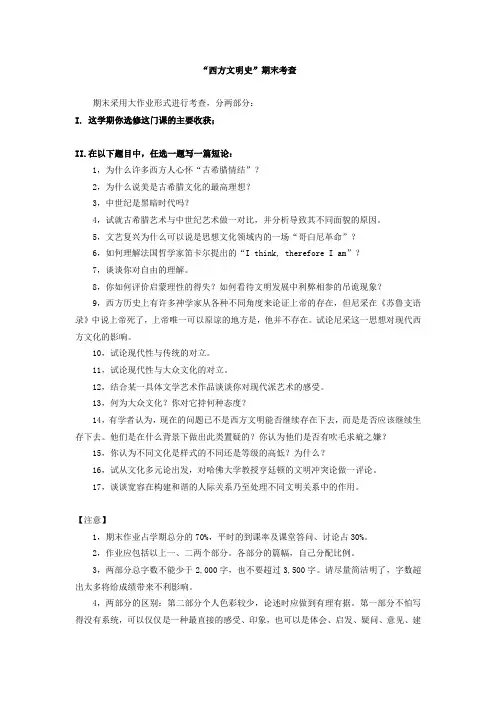
“西方文明史”期末考查期末采用大作业形式进行考查,分两部分:I. 这学期你选修这门课的主要收获;II.在以下题目中,任选一题写一篇短论:1,为什么许多西方人心怀“古希腊情结”?2,为什么说美是古希腊文化的最高理想?3,中世纪是黑暗时代吗?4,试就古希腊艺术与中世纪艺术做一对比,并分析导致其不同面貌的原因。
5,文艺复兴为什么可以说是思想文化领域内的一场“哥白尼革命”?6,如何理解法国哲学家笛卡尔提出的“I think, therefore I am”?7,谈谈你对自由的理解。
8,你如何评价启蒙理性的得失?如何看待文明发展中利弊相参的吊诡现象?9,西方历史上有许多神学家从各种不同角度来论证上帝的存在,但尼采在《苏鲁支语录》中说上帝死了,上帝唯一可以原谅的地方是,他并不存在。
试论尼采这一思想对现代西方文化的影响。
10,试论现代性与传统的对立。
11,试论现代性与大众文化的对立。
12,结合某一具体文学艺术作品谈谈你对现代派艺术的感受。
13,何为大众文化?你对它持何种态度?14,有学者认为,现在的问题已不是西方文明能否继续存在下去,而是是否应该继续生存下去。
他们是在什么背景下做出此类置疑的?你认为他们是否有吹毛求疵之嫌?15,你认为不同文化是样式的不同还是等级的高低?为什么?16,试从文化多元论出发,对哈佛大学教授亨廷顿的文明冲突论做一评论。
17,谈谈宽容在构建和谐的人际关系乃至处理不同文明关系中的作用。
【注意】1,期末作业占学期总分的70%,平时的到课率及课堂答问、讨论占30%。
2,作业应包括以上一、二两个部分。
各部分的篇幅,自己分配比例。
3,两部分总字数不能少于2,000字,也不要超过3,500字。
请尽量简洁明了,字数超出太多将给成绩带来不利影响。
4,两部分的区别:第二部分个人色彩较少,论述时应做到有理有据。
第一部分不怕写得没有系统,可以仅仅是一种最直接的感受、印象,也可以是体会、启发、疑问、意见、建议等等,还可以评说对哪些部分感兴趣,哪些内容听不懂。
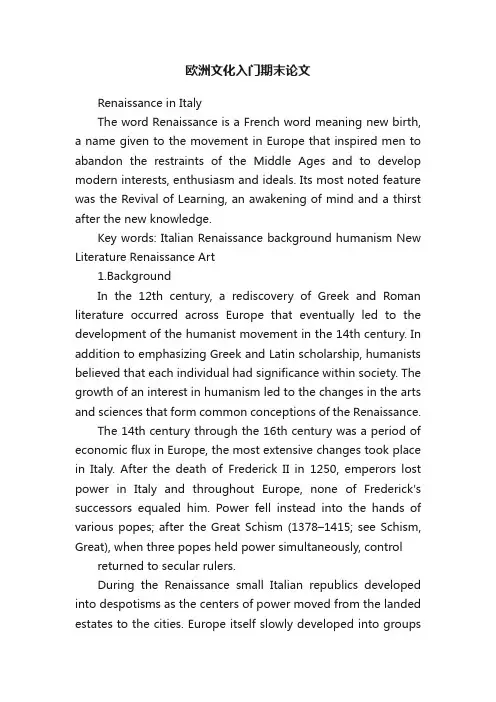
欧洲文化入门期末论文Renaissance in ItalyThe word Renaissance is a French word meaning new birth, a name given to the movement in Europe that inspired men to abandon the restraints of the Middle Ages and to develop modern interests, enthusiasm and ideals. Its most noted feature was the Revival of Learning, an awakening of mind and a thirst after the new knowledge.Key words: Italian Renaissance background humanism New Literature Renaissance Art1.BackgroundIn the 12th century, a rediscovery of Greek and Roman literature occurred across Europe that eventually led to the development of the humanist movement in the 14th century. In addition to emphasizing Greek and Latin scholarship, humanists believed that each individual had significance within society. The growth of an interest in humanism led to the changes in the arts and sciences that form common conceptions of the Renaissance.The 14th century through the 16th century was a period of economic flux in Europe, the most extensive changes took place in Italy. After the death of Frederick II in 1250, emperors lost power in Italy and throughout Europe, none of Frederick's successors equaled him. Power fell instead into the hands of various popes; after the Great Schism (1378–1415; see Schism, Great), when three popes held power simultaneously, control returned to secular rulers.During the Renaissance small Italian republics developed into despotisms as the centers of power moved from the landed estates to the cities. Europe itself slowly developed into groupsof self-sufficient compartments. At the height of the Renaissance there were five major city-states in Italy: the combined state of Naples and Sicily, the Papal State, Florence, Milan, and Venice. Italy's economic growth is best exemplified in the development of strong banks, most notably the Medici bank of Florence. England, France, and Spain also began to develop economically based class systems.2.HumanismHumanism is the keynote of Renaissance.Renaissance humanism was an activity of cultural and educational reform engaged by scholars, writers, and civic leaders who are today known as Renaissance humanists. It developed during the fourteenth and the beginning of the fifteenth centuries, and was a response to the challenge of medieval scholastic education, emphasizing practical, pre-professional and pre-scientific studies. The main centers of humanism were Florence and Naples.2.1 The main content of humanism2.1.1Man is the measure of all things, man-centered culture .It emphasize the power, value and dignity of the human beings andholding that human beings are glorious creatures. And the lines of Shakespeare’s Hamlet is the best summary of the core of Renaissance thought---the greatness of man.2,1,2Emphasize the dignity of human beings and the importance of the present life.It emphasize secular happiness and individualism against the medieval ideas of asceticism, shifting man’s interest from Christianity to humanity, from religion to philosophy, from beauty and greatness of God to the beauty of human body in allits joys and pains.2.1.3Believe human beings were glorious creatures and man has the right to pursue personal happiness, knowledge and wealth.It applies Aristotle’s theory that humanist literature mainly use realistic style and take literature as the mirror or miniature of the society. Therefore these Italians, and many others, helped to make Italy the center of the Renaissance movement in Europe. The movement changed the medieval Western Europe into a modern one.3.New literature3.1Three outstanding heroes of Florence literature3.1.1Giovanni BoccaccioFrench-born Italian poet and writer whose classic work, the Decameron (1351-1353), is a collection of 100 tales told by seven young ladies and three younger gentlemen. In 1348, a terrible plague attacked Florence. Every day, even every hour, large numbers of human remains were carried to the outskirts of the town . From March to July, the death toll amounted to more than 100000, Florence City, became a cemetery ,which is full of wild land, bones. no one could bear to look at it . In order to record human disaster, Boccaccio took this plague as a background, wrote one of the Italy's most famous short story collection" Decameron ". At that time," Decameron " was referred to as the" music", which is known as a companion with Dante’s " Divine Comedy”.3.1.2Francesco PetrarchItalian poet, scholar, and humanist who is famous for Canzoniers, a collection of love lyrics songs written in his Italian dialect. It expresses the author’s true love to his girl friend Lauraand the view of love and happiness. He praised the beauty of the girl in the reality and considered young men and women have the right to enjoy the love. He lapsed into extremely sad when Laura died of illness .A painful emotion can easily seen in his poem. Such feelings have got rid of the abstract and symbolic significance of medieval literature .We look upon him as the father of modern poetry because in his sonnets for Laura he showed himself to be a great humanist writer keenlyaware of mortal and earthly values and he ignored medieval courtly conventions and defined true emotions.3.1.3Dante AlighieriHe was commonly known as Dante, a major Italian poet of the Middle Age, the founder of Modern Italian---one of the pioneering figures in The European Renaissance. His Divine Comedy, originally called Comedy and later called Divine by Boccaccio, is considered the greatest literary work composed in the Italian language and a masterpiece of world literature. It is a narrative poem in terza rima containing 14 233 lines organized into 100 cantos approximately 142 lines each and can be calleda spiritual travel book.4.Renaissance art4.1The two peaks of Renaissance artOne is the radical break with medieval methods of representing the visible world occurred in Italy during the 2nd half of the 13th century the other is the decided break with the medieval pictorial tradition until the 2nd decade of the 15th century.4.2Distinct features of Renaissance artThe first is the breakaway from the domination of the church.The second is the changed themes of painting from purely celestial realm to an appreciation of all aspects of nature and man.The third is the studies of the ruins of Roman and Greek temples andthe revival of the principles of ancient civilization into their works.The fourth is the introduction of scientific theories of anatomy and perspective in artistic works.4.3Early Renaissance Artists4.3.1GiottoHe was the forerunner of the Renaissance who was said to have determined the course of painting in Europe. He led the way of restoring dignity to human figures. He also worked towards a more realistic depiction of space.His famous work Flight into Egypt is a painting based on the story in the Bible with Maria riding on a donkey that is ready to face the hardship ahead. She looked firm and resolute while her husband Joseph looked hesitant and sorrowful. His another painting, Betrayal of Judas is also very famous.4.3.2Filippo BrunelleschiFlorentine architect, one of the initiators of the Italian Renaissance. His revival of classical forms and his championing of an architecture based on mathematics, proportion, and perspective make him a key artistic figure in the transition from the Middle Ages to the modern era. In his designing of the churches he showed a systematic use of perspective. He also introduced motif that was widely imitated during the Renaissance.In 1420 he began to build the dome for the cathedral in Florence and it became the most original construction in the building ofdomes in the world history of architecture.Other early Renaissance artists, including Donatello, Giorgione also made great contribution to the art.4.4High Renaissance Artists4.4.1Leonardo da VinciLeonardo da Vinci was known not only as a masterful painter but as an architect, sculptor, engineer, and scientist. His pursuit of knowledge was relentless and his discoveries left lasting changes in the fields of art and science. With his sophisticated skills and love for learning, Leonardo was the quintessential Renaissance man. In painting he stressed the expression of emotional states. As a painter Leonardo is best known for The Last Supper and Mona Lisa . His other works, The Virgin of the Rocks, Vitruvian Man, Four Caricatures, are also favored by people.4.4.2Michelangelo BuonarrotiMichelangelo's extraordinary accomplishments in painting, sculpture, and architecture made him one of the outstanding figures in Renaissance art. He is known for painting the ceiling of the Sistine Chapel and rendering the human form in a wide variety of positions and with great emotional expression in painting and sculpture, and creating several of the most important works of the Italian Renaissance, such as the sculpture of David and Moses, the marble statue of Dying Slave and so on.Other high Renaissance artists, like Raphael, Titian also left many worldfamous works to us.The Renaissance resulted in numerous investigations of natural events, in a widespread study of art and literature and in a broadening of outlook to a degree never before known.Economic and intellectual changes during the Renaissance both helped to speed up Western social and cultural development and hence prepared the necessary conditions for rapid progress in political, social and ideological areas of the modern Age.。
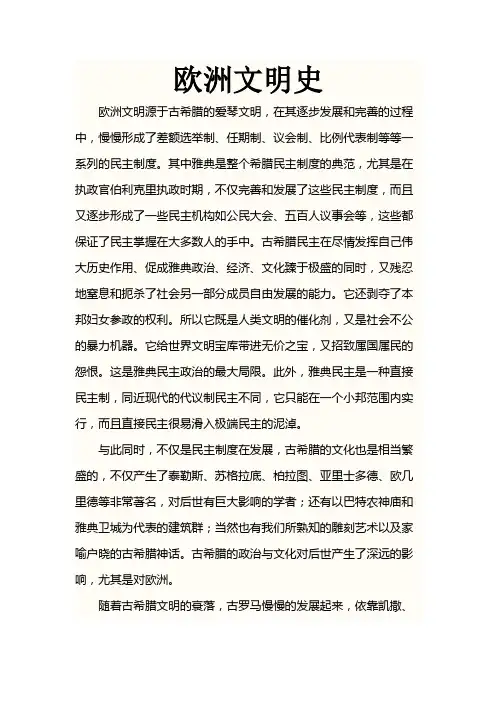
欧洲文明史欧洲文明源于古希腊的爱琴文明,在其逐步发展和完善的过程中,慢慢形成了差额选举制、任期制、议会制、比例代表制等等一系列的民主制度。
其中雅典是整个希腊民主制度的典范,尤其是在执政官伯利克里执政时期,不仅完善和发展了这些民主制度,而且又逐步形成了一些民主机构如公民大会、五百人议事会等,这些都保证了民主掌握在大多数人的手中。
古希腊民主在尽情发挥自己伟大历史作用、促成雅典政治、经济、文化臻于极盛的同时,又残忍地窒息和扼杀了社会另一部分成员自由发展的能力。
它还剥夺了本邦妇女参政的权利。
所以它既是人类文明的催化剂,又是社会不公的暴力机器。
它给世界文明宝库带进无价之宝,又招致属国属民的怨恨。
这是雅典民主政治的最大局限。
此外,雅典民主是一种直接民主制,同近现代的代议制民主不同,它只能在一个小邦范围内实行,而且直接民主很易滑入极端民主的泥淖。
与此同时,不仅是民主制度在发展,古希腊的文化也是相当繁盛的,不仅产生了泰勒斯、苏格拉底、柏拉图、亚里士多德、欧几里德等非常著名,对后世有巨大影响的学者;还有以巴特农神庙和雅典卫城为代表的建筑群;当然也有我们所熟知的雕刻艺术以及家喻户晓的古希腊神话。
古希腊的政治与文化对后世产生了深远的影响,尤其是对欧洲。
随着古希腊文明的衰落,古罗马慢慢的发展起来,依靠凯撒、庞培以及屋大维等人的东征西讨,逐步建立了一个环绕地中海的巨大帝国。
古罗马也有其特有的政治制度。
罗马法便是其中一项不朽的成就。
罗马法主要包括了《十二铜表法》和查士丁尼法典。
《十二铜表法》是古罗马第一部成文法典,是古罗马固有习惯法的汇编,它总结了前一阶段的习惯法,并为罗马法的发展奠定了基础,是“一切公法和私法的渊源”。
许多世纪以来,《十二铜表法》被认为是罗马法的主要渊源。
但它只是在一定限度内维护平民的利益,仍然保留了一些野蛮的习惯法。
它内容相当广泛,条纹比较清晰,标志着罗马成文法的诞生;审判、量刑皆有法可依,在一定程度上限制了贵族的特权与专横,保护了平民的利益;但也保留了一些比较野蛮的习俗。
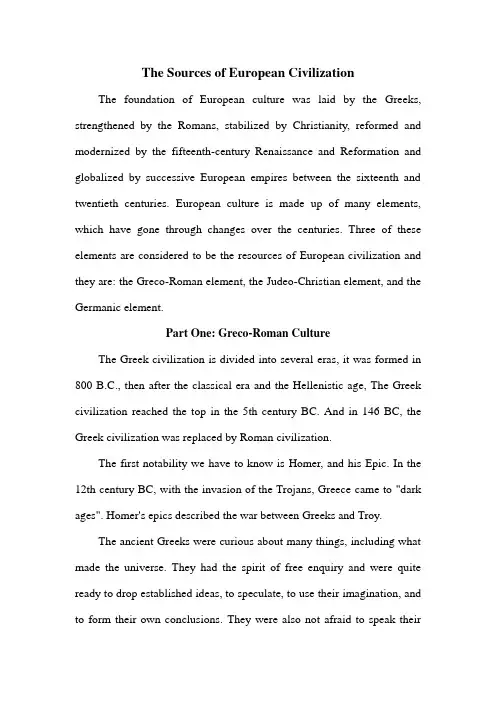
The Sources of European CivilizationThe foundation of European culture was laid by the Greeks, strengthened by the Romans, stabilized by Christianity, reformed and modernized by the fifteenth-century Renaissance and Reformation and globalized by successive European empires between the sixteenth and twentieth centuries. European culture is made up of many elements, which have gone through changes over the centuries. Three of these elements are considered to be the resources of European civilization and they are: the Greco-Roman element, the Judeo-Christian element, and the Germanic element.Part One: Greco-Roman CultureThe Greek civilization is divided into several eras, it was formed in 800 B.C., then after the classical era and the Hellenistic age, The Greek civilization reached the top in the 5th century BC. And in 146 BC, the Greek civilization was replaced by Roman civilization.The first notability we have to know is Homer, and his Epic. In the 12th century BC, with the invasion of the Trojans, Greece came to "dark ages". Homer's epics described the war between Greeks and Troy.The ancient Greeks were curious about many things, including what made the universe. They had the spirit of free enquiry and were quite ready to drop established ideas, to speculate, to use their imagination, and to form their own conclusions. They were also not afraid to speak theirminds. And also, due to the plays the Greeks performed at religious festivals early in their remote past, a powerful drama developed in the 5th century B.C.. The ancient Greece had created many philosophers and playwrights. Mainly represented by philosopher Socrates, Plato and Aristotle. Socrates pulled the importance of the free debate forward. Plato's goal was to achieve a society which can both maintains noble, and be accepted by the poor. Aristotle sought for the order for every aspect of nature and human social. The famous playwrights were Aeschylus with his Agamemnon, Sophocles with his Oedipus the King, and Euripides with his Trojan Women.Also, historical writing started early in Greece. Here we have Herodotus, who is often called “Father of History”, wrote about the war between Greeks and Persians, and Thucydides.The Greeks set an example by the bold effort they made to understand the world by the use of human reason. The body of ideas the Greek philosophers expressed, and the variety of questions the raised about the nature of the world and of human thought, knowledge and conduct, have had an abiding interest for later generations. In literature, too, they have exerted an influence which can still be felt today. Countless writers have quoted, adapted, borrowed from and otherwise use Homer’s epics, Sappho’s lyrics, the tragedies of Aeschylus and Sophocles and Euripides, Aristophanes’s comedies, Plato’s Dialogues, etc. so thattheir themes, characters, episodes, their particularly striking passages, phrases, even single words and their derivative are familiar to educated people the world over, a cherished legacy from that splendid period of human history.Then let’s come to Roman Culture. The most important contribution the Romans made to European culture was the foundation of Roman Law. Also, in architecture and art Romans made outstanding contributions, like the Colosseum and the Pantheon.Part Two: Judeo-Christian CultureAmong all the religions by which people seek to worship, Christianity is by far the most influential in the West. Every phase of man’s life is touched by this religion, so much so that it has become part and parcel of Western culture. Judaism and Christianity are closely related. In fact, it was the Jewish tradition which gave birth to Christianity. Both originated in Palestine—the hub of migration and trade routes, which led to exchange of ideas over wide areas.The Old Testament recorded the history of the Jews. Jews were once called Hebrews,strayed in Middle East Desert in about 3800 BC. In about 1300 BC, they gradually settled down in Canaan, and formed a small kingdom.Christianity and Judaism have close relationship. The core of the Christian is Jesus Christ, its doctrine is: one, Jesus Christ is the son ofgod, god sent him to men, suffer torments with humans and eventually save mankind. Second, the Christ is the only son of god , anyone who believe in Christ finally get eternal life.The major Christian classic is the bible. The "bible" is consist of the new testament and the old testament. The Old Testament has 39 parts writing about the things happened during 1000-B.C. to 100A.D. the most important parts including genesis, the exodus, "Levi remember", "the number of people remember", "deuteronomy". The New Testament came after the rise of Christian, with a total of 27 volumes. The first four volumes talks about the legend of Jesus' words and deeds, and the legend of the Jesus' apostles.Part Three: Germanic CultureIn the latter part of the fourth century the Huns swept into Europe from central Asia, robbing and killing as they came along, and large numbers of the half civilized Germanic tribes such as the Visigoths, the Franks, the Angles and Saxons, and the V andals fled their homelands in northern Europe and were pushed to cross the Danube river into the territory of the Roman Empire. In A.D. 476 a Germanic general killed the last Roman emperor and took control of the government. While the Eastern Roman Empire continued, the power of ancient Rome was gone. In its place mushroomed a great many Germanic kingdoms, which in a few hundred years were to grew into the nations known as England,France, Spain, Italy, and Germany. This is a period in which classical, Hebrew and Gothic heritages merged. And it is this fusion and blending of different ideas and practices that paved the way for the development of what is present-day European culture.Christianity played a very important role in Europe political life of the feudal society; it became the spiritual pillar of the feudal system. Christian world rejected alien and militant control (o ne of the most famous was the Crusades). Especially a few times to invade Palestine. Although it ended in failure, but promoted the cultural exchange between east and west, and prepared for the formation of the monarchy.In the academy and science, Charlemagne and his Carolingian Renaissance, Alfred the Great and his academic centre, St. Thomas Aquinas’ Scholasticism and Roger Bacon, all did great contribution to the preserve and development of the culture.In literary, there was a long Epic. The Anglo-Saxon's epic "the Europe of Woolf" is the most complete one spread until now, and the song of Roland is the most famous French epic. There were also great poets, Dante and Chaucer. And the famous Italian poet Dante's "divine comedy" is the landmark in the world literature history, expressing the upcoming Renaissance humanistic ideas. Geoffrey Chaucer is called the first short story writer in English literature history and the first modern poet, his most famous work is the Canterbury tales.The architecture and art is mainly the Romanesque and gothic, they are the extension of classical art.To sum up, European Civilization has inherited a lot from the Classical Civilization, including ancient Greek philosophy sense, ancient Roman laws, Latin language, and most significantly, Christianity.And those three cultures we have talked about are the main resources of European culture; they are all of vital importance in the development of European culture.。
欧洲文明史论文浅谈欧洲文艺复兴摘要:“文艺复兴”在人类文明发展史上标志着一个伟大的转折。
它是新文化,是当时社会的新政治、新经济的反映,是新兴的资产阶级在思想和文化领域里的反封建斗争。
关键词:文艺复兴、变革、意义引言:文艺复兴是一次人类从来没有经历过的最伟大的、进步的变革,是人类向未知精神的进军。
正文:“文艺复兴”主要是“人文主义”的兴起。
他在文学、艺术、政治思想及自然科学领域内创造了丰硕的成果。
它唤醒了人们积极进取的精神、创造精神以及科学实验的精神,从而在精神方面为资本主义制度的胜利和确立开辟了道路。
文艺复兴在欧洲历史发展中占有重要地位。
首先是人的发现。
与中世纪对比,文艺复兴在意识形态领域内带来了一系列巨大的变化。
最突出的变化是关于人价值观念的转变。
在中世纪,理想的人应该是自卑、消极、无所作为的,人在世界上的意义不足称道。
文艺复兴发现了人和人的伟大,肯定了人的价值和创造力,提出人要获得解放,个性应该自由。
重视人的价值,要求发挥人的聪明才智及创造性潜力,反对消极的无所作为的人生态度,提倡积极冒险精神。
重视现世生活,藐视关于来世或天堂的虚无飘渺的神话,因而追求物质幸福及肉欲上的满足,反对宗教禁欲主义。
在文学艺术上要求表达人的感情,反对虚伪和矫揉造作。
如:彼特拉克的《歌集》,薄伽丘的《十日谈》。
重视科学实验,反对先验论;强调运用人的理智,反对盲从;要求发展个性,反对禁锢人性;在道德观念上要求放纵,反对自我克制;提倡“公民道德”,认为事业成功及发家致富就是道德行为。
提倡乐观主义的人生态度。
这种不可抑制的求知欲和追根究底的探求精神,对一切事物都要研究个究竟,决不满足于一知半解的精神,为创造现世的幸福而奋斗的乐观进取精神,把人们从中世纪基督教神学的桎梏下解放出来,资产阶级正是在这种精神的指引下创造近代资本主义世界的。
1500年前后的地理大发现,就是这种人文主义精神的外在表现。
意大利是文艺复兴的发源地,而“地理大发现”的主角哥伦布和卡波特都是意大利人。
河北大学工商学院添些学校《xxx》结课论文题目:欧洲文化之哥特式建筑姓名:黄文泽性别:男专业:xxx班级:xxx学号:xxx欧洲文化之哥特式建筑欧洲文化博大精深历史悠久,无论是其人文艺术方面的发展还是其自然科学的严谨都吸引了广大的研究者和历史文化爱好者,经过本学期老师对欧州文化的讲解,我对本来就很感兴趣的欧洲建筑有了更深的了解和认识,下面我从其起源、建筑特点以及对现代建筑的影响简述下我眼中的欧洲建筑的代表——哥特式建筑。
哥特式建筑是中世纪下半叶起源于法国13——15世纪流行于欧洲的一种建筑风格。
主要见于天主教堂也影响到世俗建筑。
哥特式建筑以其超高的技术和艺术成就,在建筑史上占有重要是地位。
其特点主要是尖塔高耸,尖形拱门,大窗户及绘有圣经故事的花窗玻璃.营造出轻盈修长的飞天的感觉.以及新的框架结构以增加支撑顶部的力量.使整个建筑以直线线条,宏伟的外观和教堂内空阔的空间, 再结合镶着彩色玻璃的长窗,使教堂里产生一种浓厚的宗教气氛.教堂的平面仍是基本的拉丁十字型,但是其西端门的两侧增加一对高塔。
哥特式建筑结构也十分多样,主要有尖肋拱顶,飞扶壁,花窗玻璃等,下面就各国建筑代表为例来介绍哥特式结构在建筑上的体现。
意大利的哥特式建筑于十二世纪由国外传入,主要影响于北部地区.意大利没有真正接受哥特式建筑的结构体系和造型原型,只是把它当做是一种装饰风格,所以在意大利很难找到纯粹的哥特式建筑.威尼斯的世俗建筑有很多的杰作,圣马可广场上的总督宫被认为是中世纪的世俗建筑中最美丽的作品之一,成为广场的标志.城市里一般建有许多高塔,总体轮廓线很美.德国最早的哥特式教堂之一的科隆主教堂于1248年兴工,由建造过亚眠主教堂的法国人设计,有法国盛行的哥特式建筑的风格.德国的教堂很早就形成了自己的形制和风格,如德国的马尔堡的圣伊莉莎白教堂的建筑结构体现了德国教堂建筑的最早特点:屋顶平缓,陡坡屋面罩在拱顶上,高度相等的教堂中厅和侧厅,教堂内部采光是依靠端体墙上高窄普通的窗户,全然去除尖顶、高侧窗、飞扶壁等等之类的样式,可谓一大创新。
我眼中的西方文明史(西方文明史论文)西方文明史期末作业Written by XHNWestern civilization in my eyes After learning this lesson for one term,I know a lot about western in many fields such as mythology、philosophy、festival and communication. How can I describe the western civilization? I think it’s one part full of amazing、wisdom、freedom and convert during the synchronous development of the western world.We have learnt several mythologies and I find that the “god” in western mythology is not a serious image, opposite, ZeuS, gods’ leader, always does m any self-willed things which sounds uncomfortable. Just because of it, the “god” makes people feel real and vivid. Not as our country, western people may prefer to believe gods is more similar to normal people, I think, at the least in emotion part.How about philosophy? We also know many philosopher from our country like Lao Tz and Chuang Tse, they usually spread their idea by teach others and write some book. But in ancient Greece, there are three famous philosopher called Socrates、Plato and Aristotle. They prefer to communicate with others than teach others what they think about. I think if we defined that Chinese philosophy likes teaching, then, western philosophy may likes debating. I should admit that the academic atmosphere in that time in western was good, I still remember there are a paint named “the school of Athens”, painted by Raphael, describe how crowd during the school, it reflect that at that time there are many people have huge thirst of knowledge, they have some topic such as “what made the world”、“what’s the resourceof the world”…… In a word, the philosophy in western civilization usually make me associate freedom and holy, it’s one thing tha t you are willing to devote your whole life to learn.There is one well known book called “the Bible”, many festivals are come into being from this book, like Christmas and Easter Day, two festival which used to commemorate the born and revive of Jesus. Different from our country, most of the western festival is closely related with religion, we can see that the belief is too important for western people.As for communicate, I think it’s more affected by political system, freedom and open atmosphere full of the whole western world so that people can express personal opinion without any hesitate. I think it’s a good society custom and will do well for one country’s development.In my eyes, the western civilization is one thing that we would appreciate rather than study it. The civilization show us a glorious thing which created by human, we should know not only our country have broad and profound culture, but also the western world have, so we should learn from each other in mutual emulation.。
近代欧洲民族国家的形成及意义——吴文卓5090309465内容提要:中世纪的欧洲从名义上讲还处于神圣罗马帝国与罗马教会的统治之下。
当时的欧洲可以说处于神权下的统一中,欧洲各地几乎还没有形成民族国家的概念。
随着近代的到来、文艺复兴影响的扩散(方言文学兴起及地理大发现等),法国、英国、德国、意大利等主要国家相继诞生并逐渐活跃于欧洲政治舞台之上。
关键词:欧洲民族国家形成原因崛起中古的欧洲,一方面封建制度早已确立,许多独立的庄园、城市林立,领主之间相互征伐频繁,社会乱象丛生,分裂是主旋律。
另一方面,教皇与神圣罗马皇帝又都想通过自己的权力和影响力再现罗马帝国治下的那个统一的欧洲世界。
生产关系所决定的社会制度所带来的分裂势力与强大的世俗权力对统一欧洲的极度的追求和渴望相互作用,近代欧洲各主要国家就是在这样的矛盾背景下、在不断地调和矛盾的过程中产生的。
“列国的成立,是中古收场的一个重要表征。
中古之时,欧洲外蒙统一知名,内具分裂之实。
列国既兴起,乃把统一的面幕撕开,把封建的乱象扫除;政治上的欧洲,始达到了名实相符的地位。
”列国产生的原因(宏观)诚然,不同的国家的形成有着各自不同的诱因,但从宏观的历史规律的角度去看,共同的背景使得这些国家在产生原因上也有相同之处。
首先,各国君主的权力日渐扩大。
割据与战乱使得欧洲人民生活水深火热,虽然神圣罗马皇帝和教皇都致力于统一欧洲,但随着二者权势的跌落,这一梦想也就化为泡影。
代之兴起的各地君权,能够收束地方诸侯、稳定局面,他们的日渐强大顺应了历史潮流,为列国的形成及地位巩固打下了基础。
“列国的成立,乃是君权伸张的结果,因为列国对于封建是一个集合的运动。
”其次,随着生产的发展,欧洲城市兴起,资产阶级产生并日渐壮大。
这些人以商贸为生,渴望秩序与和平,畏惧战乱。
于是,他们也就极力支持本国君主对于国家成立的努力。
而且,本国君权的加强又可以使得他们进一步摆脱教会的羁绊。
因此,当国王与教皇起冲突时,总能从他们那获得极大地支持。
THE SIGNIFICANCE OF THE CRUSADES It is well known in the seventh and eighth centuries Muslim armies swept across the Middle East, North Africa and even into Spain. By 750 AD, this Muslim empire replaced the Roman Empire as the dominant power in this region of the world. But what is less well-know is how the Muslims embraced the Greco-Roman culture they encountered. Conquest brings disparate civilizations together. Specifically, conquering Alexandria, Egypt, once the intellectual center of Hellenistic Greece, meant Muslim intellectuals had broad access to the greatest works of the classical world. They studied Hippocrates and Galen, translated them into Arabic, provoking advances in Muslin medicine. They translated Pythagoras and Euclid, leading to progress in Muslim math. Algebra and Algorithm are Muslim words, deriving from the titles of the works of one of Islam’s great mathematicians, Muhammad in Musa al-Khwarizmi, the greatest Muslim mathematician of the Middle Ages. They preserved the writings of Archimedes and Ptolemy, the father ofmap-making.The most important thinker Arabs encountered was Aristotle. Not all of Aristotle’s works were lost to the West after the fall of Rome, but man y were. Most importantly his cosmology had fallen out of favor in the Christian West. Thanks to St. Augustine, Plato remained a highly reputable pagan philosopher, certainly more so in Church eyes than Aristotle because Plato believed in the immortality of the soul and posited the existence of an eternal, perfect realm,or idea. Aristotle loved the material world too much for most Church Fathers. He even believed in an infinite world without a creator. But he was beloved by Muslims, earning titles like The Wise Man and First Teacher. His scientific and empirical thought was transfused across the Muslim Empire in Arabic translations by Muslim philosophers like al-Kindi and al-Farabi, or as the Muslims called him, The Second Teacher. A Golden Age in Muslim intellectual history bloomed. By the turn of the first millennium, Muslim medicine, Muslim science and Muslim mathematics were the most advanced in the world.The Crusades changed all of this. For two hundred years, Christian soldiers voyaged eastward and into Spain, ostensibly attempting to free these areas from Muslim control, but in reality, opening Christian Europe to Muslim works. Or more precisely, they reacquainted Europe with her own culture heritage. After Muslim preservation, the works described above were translated from Arabic into the dominant European language, now Latin. Literally thousands of manuscripts appeared, quite an impressive number before the printing press. Abelard of Bath, for example, completed translations of al-Khwarizmi and Euclid from Arabic into Latin. Gerard of Cremona translated dozens of works, including Ptolemy’s Algamest. And Averroes remains an important figure in the history of Western thought for his popularization of Aristotle. This was a turning point in Western intellectual history because it ignited what historians have labeled as a “Twelve Century Renaissance” during which timethe works of the above authors were recovered, translated and studied. It may not be as famous as the subsequent fifteenth and sixteenth century Renaissance centered in Florence, Italy, but it laid the foundation for the latter. Europe was about to become a center for science, math and philosophy once again.It was the newly recovered Aristotle that created the most intellectual ferment in the wake of the Crusades. His ultimate acceptance required his ideas be fused with Catholicism, especially his emphasis on logic, which many believed threatened the Catholic emphasis on faith. The first to attempt systemization was Peter Abelard, who may have been the greatest genius of the twelve century, as well as its most controversial figure. He was always armed with texts of Aristotle, some of which had recently been translated from Arabic to Latin. Abelard was probably the most qualified yet least able to reintroduce Aristotle to the Western world. He was a clergyman, but it was not in his nature to follow the rules.Enter Catholicism’s greatest philosopher of the second millennium, St. Thomas Aquinas. Aquinas refused to believe that faith and reason were two irreconcilable fields of inquiry. Although Aquinas explicitly condemned some of Aristotle’s positions, such as his belief in an infinite world, Aquinas’ epistemological method combined Aristotelian logic and his emphasis on the material world: Aquinas reasoned that everything, including the physicalworld, must have a first cause or creator, for how can anything exist without a first cause? He used logic to refute atheism. He engages in natural theology, or the study of God through reason and obser vation, not just faith: “The existence of God and other like truths about God, which can be known by natural reason, are not articles of faith, but are preambles to the articles; for faith presupposes natural knowledge, even as grace presupposes nature and perfection the perfectible.” Religious truths can be discovered from observation, even without Scripture or faith. Theology and philosophy are united. Even though Aquinas never would have classified himself as an Aristotelian, without Aristotle, there never would have been Aquinas.Moreover, following Aristotle, Aquinas saw no problem with accumulating wealth. The poor man is no holier than the rich man if the latter uses his wealth to help others. Refuting the deeply ascetic Franciscans, the Dominican Doctor contends that poverty by itself is not a virtue. To some degree, Aquinas is merely responding to the nascent capitalism in post-Crusades Europe. By the thirteenth century, a scientific-materialism has entered the Western intellectual and cultural tradition. It has never left.Intellectual revitalization is the real significance of the Crusades. Fields like science, mathematics and philosophy made more progress in the twelve and thirteenth centuries than in the preceding six centuries combined. The Black Death momentarily curbed intellectual growth in the fourteenthcentury, but by the fifteenth century, Europe was poised to become the world’s dominant civilization.。
西方文明史期末考试姓名:白乙静班级:英语1201班学号:1120112106 得分_________ Humanism in the RenaissanceThere is a famous saying:“Human is the measure of all things”said by sophists whose thought has originally opened the door of Humanism during the sixth century b.c.Humanism is an important thought which formed the foundation of the development of Western political,economic and cultural.The Renaissance is the cradle of humanism which pushed this idea to the peak.Meanwhile,the Renaissance was marked by the spread of humanism,so Humanism is the great spirit and the essence of Renaissance.The Renaissance is a great historical cultural event which has an incredible influence in western countries, especially in Italy, France, Spain, England and other countries. Science,philosophy,politics,literature,art have developed a lot during the Renaissance.It took place in 14 ~ 16th century which reflected the requirements of bourgeoisie in Western Europe various countries. During the mid-century,the leading thought is church-centered thought which based on the theological worldview.The medieval Catholic teachings were characterized by God-centeredness, otherworldliness and asceticism.They hold the view that the nature of human is guilty, the highest duties of human is to atone to the God.This idea limited people’s thought and prevent the development of Capitalism.With the expand of the capitalisteconomy,bourgeois class’s various desire became stronger and stronger.At that moment,the Renaissance appeared as the time require. Renaissance sprang as a result of rediscovery and restudy of the Greek and Roman civilization which is based on the conception that the man is the measure of all things, the man-centered culture. It’s also the result of opposition of the medieval theological worldview and the germination of capitalism.Under the dark rule of religion,humanist began to look at the problems of God and Providence with a view to understand man’s work and man’s earthly happiness. Contrary to the subordination of individuals to the feudal rules and the sacrifice of earthly life for a future life in the medieval society, Renaissance humanists found in the classics a justification to exalt human nature and came to see that human beings were glorious creatures capable of individual development for perfection.They dug up “lost texts ”from the forgotten corners to revive the humanism. In reviving classic Greek and Roman culture, they believed they were reviving the past of man in the ancient times and helping developed the capacities and powers that the Greeks and Romans once possessed.The heart of the renaissance philosophy was the assertion of the greatness of man. By emphasizing the dignity of human beings and the importance of the present life, humanists voiced their beliefs that man did not only have the right to enjoy life, but had the ability to perfect himselfand to perform wonders.The most important point of humanism is to pay more attention to human instead of church. From daily life to the whole society, from history to spirit, humanists who fought against fate declared that everyone be born to equal.I do agree this idea,because we shouldn’t judge people by their social status like Catholic Church. The idea that everyone was born with First Sin will put people to a ideological prison that prevent their development. These humanists spoke highly of real life and encouraged people to pursuit happiness and love.They declared that everyone should have the chance to get whatever he or she wanted, which gave capitalism a possibility to bud and grow up stronger.Literature is the representative of this idea,and it also have been created splendidly during this period.Humanists have different opinions about literature, and they thought that literature could build up one’s spirit and values. While medicine could cure the dying, literature and philosophy could save their souls. Compared to philosophy, literature was more interesting and attractive, since it could make up stories to let people know complex philosophy. As a result, humanists thought highly of literature, for it lead to the glory of spirit about human beings, thus woke them up in the great darkness. Many great scholars devoted themselves into literature. This is best summarized in the lines ofShakespeare:“What a piece of work is man; how noble in reason; how infinite in faculty , in form and moving how express and admirable ; in acting how like an angel; in apprehension how like a god!”Shakespeare’s Hamlet Emphasized the power, value and dignity of the human beings and holding that human beings are glorious creatures.There are also a lot of humanists who made crucial contribution to the renaissance from the literary field to the field of painting:Bogachu's "The Decameron" ,Rabelai’s "giant" and Cervante’s "Quixote" fully elaborated humanism and satirized the previous old ideas.Da Vinci’s, Michelangelo’s and Rafael's pantings also praised the greatness of the human nature.These great humanists bravely expressed their view against the church-centered thought.The idea of humanism played a important role in Western history and highlighted the culture of civilization.Though emphasizing secular happiness and individualism against the medieval ideas of asceticism,Humanism shifted man’s interest from Christianity to humanity, from religion to philosophy, from beauty and greatness of God to the beauty of human body in all its joys and pains.It waked up the desire of human’s inner thought and facilitate them to fully play their own ability.Besides,it liberated people from social hierarchy then made the foundation of following bourgeois revolution.Humanism offered asubstantial basis of revolution against the feudal rule and became the guiding ideology of the development of capitalism.What’s more,Humanism helped to civilize man, to make him realize his potential powers and gifts. It contributed a great deal to the progress of human society. It represented the new ideas of the rising bourgeoisie. Thomas More, Marlowe and Shakespeare are the best representatives of the English humanists. The humanistic ideas and belief permeated the literature of this period.In addition,it promoted the appear of the modern natural science and Social Science.But every coin has two sides,the negative influence and limitations of the humanism couldn’t be overlooked.The humanism emphasized too much on the individuals, which may be easy to cultivate the subjectivity and extreme individualism.The extreme individualism had done harm to the social justice because the bourgeois class chase their own wealth too much.In the long run,the individualism lead to the colonialism such as “be crazy for gold”and the opening of new sea routes.This idea even arouse the Mammonism which is bad for the social atmosphere.The Humanism has a profound influence on the human civilization.It not only influence the political and cultural area but also pour a fresh blood to modern fashion. As we can see,what is the most fashionable must be the things of their own personality. We all admire the singer or painter who has their individual feature.But we shoudn’t transform thisidea to extreme individualism or selfishness. So,what we should do is to draw the advantages and avoid disadvantages of it.We’d better to seek our own desire bravely and meanwhile obey the principle of social justice.Only in this way can we highlight the civilization and mine our potential to continuously create new things.。
对欧洲文明史的哲学反思
摘要:研究了欧洲文明的特性,认为欧洲文明史的特性是作为进展的事实,这种进展的事实借着真理语言构造着文明,而这种真理语言的传统源于希腊精神。
欧洲文明在物质层面和精神层面都继承了希腊精神。
欧洲文明带给近代世界的政治文明、法律文明和物质文明都是希腊哲学的现实展开。
关键词:欧洲文明;现实展开;希腊哲学
近代世界的一系列不同于传统世界的现象,很大程度上源自欧洲文明对世界的影响,而近代世界之所以是这样而不是那样,正是欧洲文明的特性决定的。
近代世界的多种问题实际上还是欧洲文明的近代性问题,如构建民族国家面临着国家间冲突,推进政治民主面临着传统习俗的文化制约,文化多样性与普适性彼此较量,技术统治社会及社会化大生产又形成对人的异化。
这些近代性的问题为全世界所面临,必须探索问题的根源才能对人类的下一步有所裨益。
一、欧洲文明的特性
文明是指一种先进的社会和文化发展状态。
法国学者基佐对欧洲文明的这种进展状态早已作过分析,他在其著作《欧洲文明史———自罗马帝国败落起到法国革命》中阐述了以下几个问题:①文明是一个普遍的、隐蔽的、复杂的事实,是一切其他事实的归宿和总结[1]。
文明这个词所包含的第一个事实是进展、发展这个事实[1]。
②法国是欧洲文明的中心和焦点[1]。
③基督教是文明的一大关键[1]。
④罗马遗传给欧洲文明的要素:一方面,地方自治的制度,它的习惯、规章、先例、自由的原则;另一方面,一套广泛而一律的民法法规,绝对权力的观念,神圣的最高权力的观念,皇帝的观念,秩序与臣服的原则[1]。
⑤欧洲文明的显著特性是欧洲文明的诸成分中,没有一个能成功地统治我们的社会,或者至少统治得如此完全以致奴役或逐出其他成分[1]。
⑥宗教改革是一次人类心灵追求自由的运动,是一次人们要求独立思考和判断迄今欧洲从权威方面接受或不得不接受的事实和思想的运动。
这是一次人类心灵争取自治的尝试,是对神领域内的绝对权力发起的名副其实的反抗[1]。
依据基佐对文明的表述,可以看出他把文明界定为事实,而且是一种符合进展的事实。
可见,在他看来欧洲文明之与其他文化的区别主要是进展这一特性。
欧洲文明之所以称之为文明而不是称之为文化,是因为欧洲有真理传统构造文明,有公理传播文明。
这种传统来自希腊哲学的逻各斯精神。
欧洲文明之所以能拓展知识而不是重复知识如其他文化那样,就在于欧洲文明中的希腊哲学追求实证,重通约。
正是欧洲文明在源头上的希腊特性,决定了欧洲文明拥有这种进展事实的特性。
二、欧洲文明深受希腊精神的影响
基佐说法国是欧洲文明的中心和焦点,是在罗马帝国败落以后,但在更原初的欧洲文明中,希腊才是欧洲文明的中心,不管在精神层面还是政治层面。
所以希腊精神深刻影响着欧洲文明的主要领域。
欧洲文明在精神层面主要表现为基督教。
关于基督教的作用基佐总结说:基督教是一种精神势力,一种精神力量,一种完全依靠人的信念、道德信条和情操的力量,出现在一个物欲横流的社会中,带来了极大的好处。
如果没有基督教教会,整个世界必将完全被物质力量所俘虏。
教会单独发挥了一种道德力量[1]。
这里他强调了在基督教中人自身的力量,人自己的道德力量借助基督教持存着。
他又说教会的出现,产生了宗教势力和世俗势力分离,这种分离乃是信仰自由的根源[1]。
这里他又指出了基督教使人得以信仰自由这种辩证关系。
在说明基督教世界中宗教势力和世俗势力截然分开时,基佐拿伊斯兰教作了对比。
他说基督教中宣传宗教的愿望和征服别人的愿望并不共存于同一个人身上。
阿拉伯人则相反,他们既是征服者同时又是传教士,是宗教势力和世俗势力的结合[1]。
以阿拉伯作对比,基佐进一步说明基督教是信仰自由的根源这一特点。
基佐不仅认为基督教对世俗势力有平衡作用,也认为基督教对人性的自由本质有护持作用。
追根溯源,正是希腊哲学的思维方式,才产生了如此这般的基督教。
比如:基督教中有关善的理念就来自希腊哲学各派对好人和好公民的讨论,基督教爱的理论和末世说就深受毕达哥拉斯以及柏拉图的灵魂不灭与轮回思想的影响。
斯多亚派的世界主义学说也为基督教的世界主义奠定了理论基础。
从神学意义上说,基督教的思考方式是希腊式的,继承了希腊精神的很多特性。
欧洲文明在政治层面上表现为政治文明的多样性。
基佐认为欧洲文明的显著特性是在欧洲文明的君主、城市、教会中,没有一个能成功地统治我们的社会。
封建君主、教会、自由市都有相对独立的势力,维持着相对的平衡。
1789年的第三等级,从政治角度看,是12世纪自治市镇的后代和继承者[1]。
城市在11世纪后有了不同程度的自治权,而城市的相对独立作用,对于欧洲后来的政治变局影响深远。
在城市中主要是中产阶级的力量,这些中产阶级的市民精神,是近代思想的重要的和直接的来源。
市民精神作为市民地方自治的必然产物,也逐步形成了近代欧洲市民社会。
自治市早在希腊城邦时已经出现,欧洲市民的自我意识也受到了希腊罗马人的公民观念影响,所以说,追溯欧洲文明此一显著特性必然要溯源到希腊精神。
三、欧洲文明是希腊哲学的现实化
有人说,一部西方文明史,就是一部西方哲学史的展开。
这是因为:“所谓欧洲的历史就是一部展开的形而上学,历史及关于历史的一切尺度也随形而上学一同展开。
”[2]这里之所以说欧洲文明史是希腊哲学的现实化,是基于整个西方历史和世界是按照亚里士多德所规定的物理与后物理来展开的。
亚里士多德提出的动力因、目的因、质料因、形式因在近代释放出的几何级能量,推动了希腊哲学现实出广泛的自然秘密。
动力因在近代释放出机械动力学;目的因在近代释放为进化论并进而认为自己是进步的,且以之传播西方文化。
把生物进化转为社会进化就是把目的论转为进化论;质料因在近代变为物质因;形式因变为近代数学等指数关系。
这些都与近代世界的种种面相息息相关。
可以说,亚里士多德所规定的物理与后物理对欧洲近代科学和社会起着发动机一般的作用。
希腊哲学的现实化突出表现在欧洲文明的政治文明、法律文明、物质文明等方面。
(1)希腊哲学对欧洲政治文明的影响。
欧洲政治文明的重要特征是民主,而直接民主制,起源于古希腊的雅典等城邦。
在这些城邦中,全体公民直接参与公共事务辩论和政治决策,“在法律之下分享权利和义务”[3],这一民主政治传统是欧洲政治文明的最主要来源。
之后的间接民主制如代议制,也是希腊城邦传统的又一形式。
因为无论是直接民主制还是间接民主制,都以承认公民的自由、平等为前提,这种崇尚自由平等的思想就源于希腊哲学关于政治学的讨论和设想。
(2)希腊哲学对欧洲法律文明的影响。
《拿破仑法典》继承了罗马法,尤其是罗马法遗产中的民法。
这种民法的实质是公民权利的保障问题,这与希腊公民权利至上是一以贯之的,这也得益于希腊哲学的真理语系构造了公民社会形态。
法国的《人权宣言》对欧洲文明影响深远,主要是它宣告了人的平等和基本
权利,将“法律面前人人平等”作为欧洲法律文明的一个标志。
这是文艺复兴运动的结果,而文艺复兴运动的核心概念———自由、平等,又深受希腊哲学中人本主义的影响[4]。
文艺复兴运动后重申了希腊哲学对人的肯定。
(3)希腊哲学对欧洲物质文明的影响。
众所周知,近代社会在很大程度上是欧洲科技文明带来的结果。
几次科技革命极大地解放了人,创造了人类前所未有的财富。
然而,若是没有希腊哲学的复苏,又怎能想象近代科学以及其衍生品几何级般的扩张。
近代自然科学的每一次进展,都是自由意志冲破旧的观念的结果。
希腊哲学的核心是热爱智慧、追求真理,这是科学得以进展的一种内在的源动力。
希腊早期自然哲学家开创了欧洲科学的传统,后来的科学家关于天体物理学和数学等知识,往往是继承着希腊哲学家的足迹。
希腊哲学中的人本主义特质,又鼓励着人去自由思想,这也成为欧洲物质文明中科学精神的重要内容。
所以说希腊哲学是近代科学所以能产生并转化为生产力的首要条件,欧洲物质文明中的科学传统和科学精神得益于希腊哲学[5]。
四、结语
欧洲文明的两大源泉是希腊精神与基督教文明。
源于希腊哲学的政治文明和科学思维方式,构成了欧洲文明的核心。
欧洲文明走上近代之路,世界真正成为世界,都是与政治文明和科学思维的展开及其衍生品相关联的。
基督教作为西方文明的另一个源泉,也深受希腊哲学影响。
所以说,欧洲文明史就是一部哲学史的展开,是一部形而上学史。
欧洲价值的核心即是希腊哲学,欧洲社会的近代性源于哲学的希腊性。
参考文献:
[1]基佐.欧洲文明史:自罗马帝国败落起到法国革命[M].程洪逵,沅芷,译.北京:商务印书馆,1998.
[2]陈春文.回到思的事情[M].武汉:武汉大学出版社,2007:12.
[3]徐大同.西方政治思想史[M].天津:天津教育出版社,2000:19.
[4]杨娅.论哲学对人类文明的贡献[J].云南社会科学,2004(4):38-41.
[5]郭玉琼.希腊哲学精神与西方文明关系初探[J].合肥工业大学学报:社会科学版,2006(1):164-166.。